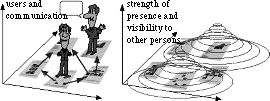| CoBrow Details Vicinity and Metrics The term vicinity is at the core of the CoBrow service. It describes the fact that several users are temporarily close to each other in the Web. The degree of closeness is mesasured with metrics. One such metric is the number of links between the pages viewed by two users at the same time. If the users are on the same page, their distance is 0, if one or the other would have to follow 2 links to be on the same page, their distance is 2. Other metrics are time or document content.
The CoBrow System CoBrow consists of many functional entities. The core functionality is built on the Vicinity Evaluator, also referred to as the CoBrow server, which is typically co-located with a WWW-server. Based on location information, it calculates the vicinity of all users according to one or more metrics. The Vicinity Evaluator is probably the most complex CoBrow component. This is not only because it has to deal with a vast amount of data. There will be many Vicinity Evaluators in the Internet - CoBrow is a fully distributed service.
The vicinity visualization is presented to the user by CoBrow clients. Today CoBrow clients are implemented as Java-applets, downloaded into the browser software as soon as a user enters a CoBrow-enabled server.
Synchronous Communication tools can be started and controlled from CoBrow. They are however not an integral component of CoBrow. CoBrow is able to use many different synchronous communication tools such as the MBone tools, the WebMedia toolkit, and CUSeeMe. An interface to the plain old telephone system and ISDN is under development. |
 The Web is the base
infrastructure of the virtual world. It is depicted as 2 dimensional hyperspace although
it is actually a graph. The left side shows a simplistic representation of two persons at
different locations. The right side shows the values of the persons' visibility functions.
Persons see each other if the visibility overlaps.
The Web is the base
infrastructure of the virtual world. It is depicted as 2 dimensional hyperspace although
it is actually a graph. The left side shows a simplistic representation of two persons at
different locations. The right side shows the values of the persons' visibility functions.
Persons see each other if the visibility overlaps.  All Vicinity
Evaluators communicate with each other to exchange information on Web users using an
http-compliant protocol. The inter-Vicinity Evaluator communication is entirely
transparent to the CoBrow clients. For the client software it is only one CoBrow service
which is actually provided by many interactive Vicinity Evaluators.
All Vicinity
Evaluators communicate with each other to exchange information on Web users using an
http-compliant protocol. The inter-Vicinity Evaluator communication is entirely
transparent to the CoBrow clients. For the client software it is only one CoBrow service
which is actually provided by many interactive Vicinity Evaluators.  These clients serve
as user interfaces not only to show the user where he is and who his neighbors are, but
also to configure the vicinity calculation, and to start external communication tools. A
VRML-based client with advanced vicinity visualization techniques is under development.
These clients serve
as user interfaces not only to show the user where he is and who his neighbors are, but
also to configure the vicinity calculation, and to start external communication tools. A
VRML-based client with advanced vicinity visualization techniques is under development.